Pfitzinger Pete - Advanced Marathoning
Здесь есть возможность читать онлайн «Pfitzinger Pete - Advanced Marathoning» весь текст электронной книги совершенно бесплатно (целиком полную версию без сокращений). В некоторых случаях можно слушать аудио, скачать через торрент в формате fb2 и присутствует краткое содержание. Год выпуска: 2008, Издательство: Human Kinetics - A, Жанр: Спорт, на английском языке. Описание произведения, (предисловие) а так же отзывы посетителей доступны на портале библиотеки ЛибКат.
- Название:Advanced Marathoning
- Автор:
- Издательство:Human Kinetics - A
- Жанр:
- Год:2008
- ISBN:нет данных
- Рейтинг книги:5 / 5. Голосов: 1
-
Избранное:Добавить в избранное
- Отзывы:
-
Ваша оценка:
- 100
- 1
- 2
- 3
- 4
- 5
Advanced Marathoning: краткое содержание, описание и аннотация
Предлагаем к чтению аннотацию, описание, краткое содержание или предисловие (зависит от того, что написал сам автор книги «Advanced Marathoning»). Если вы не нашли необходимую информацию о книге — напишите в комментариях, мы постараемся отыскать её.
Advanced Marathoning — читать онлайн бесплатно полную книгу (весь текст) целиком
Ниже представлен текст книги, разбитый по страницам. Система сохранения места последней прочитанной страницы, позволяет с удобством читать онлайн бесплатно книгу «Advanced Marathoning», без необходимости каждый раз заново искать на чём Вы остановились. Поставьте закладку, и сможете в любой момент перейти на страницу, на которой закончили чтение.
Интервал:
Закладка:
The most important workouts in this schedule are the medium-long runs with 14 and 10 days until marathon number 2 and the  O 2max session with 12 days to go. If you need to do two marathons just 4 weeks apart (and need is a relative term), then this schedule should maximize your chances of success.
O 2max session with 12 days to go. If you need to do two marathons just 4 weeks apart (and need is a relative term), then this schedule should maximize your chances of success.
Racing Strategies
Don’t do it!
Just kidding. You should definitely set a clear goal for the second (or third, or fourth,) marathon you’re running within a brief time frame. Otherwise, you might very well find yourself a few miles into it already wondering, What am I doing here? Being able to state what you want to accomplish in your multiple marathoning will provide en route direction and motivation. The longer you’ve allowed between marathons, the more precisely you should be able to state your goals for marathon number 2 (beyond “to get through it”).
Once you’ve picked your goal, map out the splits you’ll need to hit. Throughout this book, we’ve stressed the merits of showing restraint early in the marathon to maximize your chances of being able to run a strong second half. That advice is especially pertinent if you’ve already finished one marathon in the last 12 weeks or sooner. Your multiple-marathoning experience will almost certainly become a self-fulfilling death march if you run too fast early in the race in the hope of building a cushion against an inevitably slower second half.
Wait until the week before your second marathon to decide on a time goal. Be realistic, taking into account how your recovery from your first race went; the quality of your long runs, tempo runs, and interval sessions in the interim; and whether you’ve felt your energy level rise during your taper for marathon number 2.
Also consider the circumstances of your previous marathon. For example, if you ran a huge personal record (PR) off of negative splits, then there’s probably room for improvement this time around. Or say you wilted over the last 10K the last time around and realize in retrospect that this was because of a too-aggressive first 10 miles (16 km); you should be able to make another attempt at your goal time for the first marathon. If, however, you prepared with monk-like devotion for 24 weeks for your previous marathon and shaved 3 seconds off your lifetime best, and your second marathon is 4 weeks later, well, sorry, but this probably isn’t the time to try for a 10-minute PR.
If you’ve never consciously tried to run a marathon with negative splits, this might be the occasion to do so. Give yourself the first several miles to get an accurate feel for how your body is responding to the challenge you’ve set for it, and pick up the pace only when you’re fairly confident that you can sustain it to the end.
After the Marathon
If you’ve just run two or more marathons within a brief time span, your best strategy for future success is to take a well-deserved break. A few weeks of no running or easy training will help your body to recover and your mind to develop new challenges. You have little to gain by rushing back into training, and your risk of injury is exceptionally high at this point, owing to the reduced resiliency of your muscles and connective tissue after running multiple marathons. If you choose to keep training, then the 5-week recovery schedule (mesocycle 5) in chapter 10 will help you recover and rebuild your training safely.
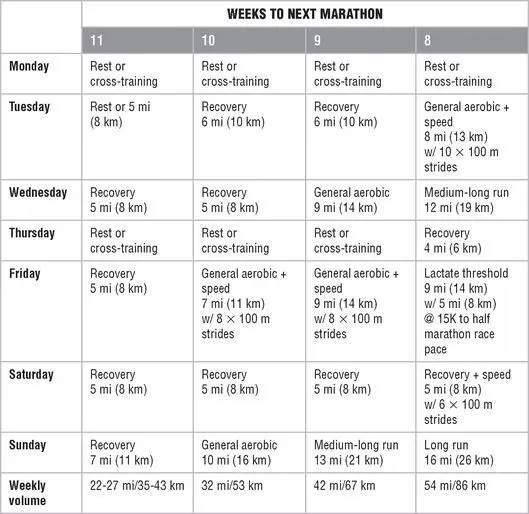
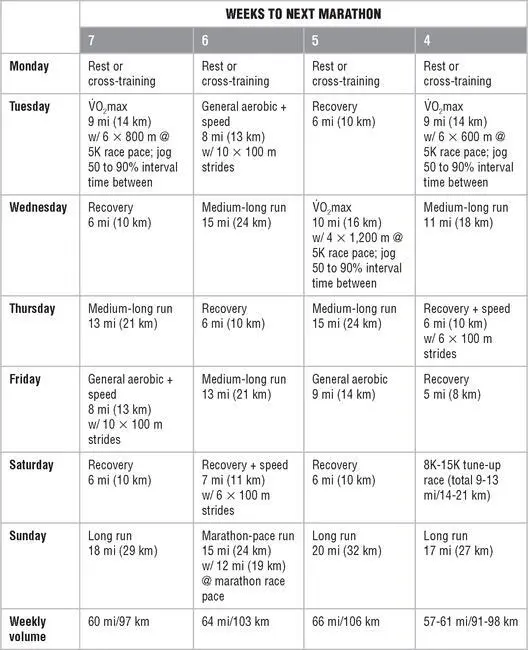
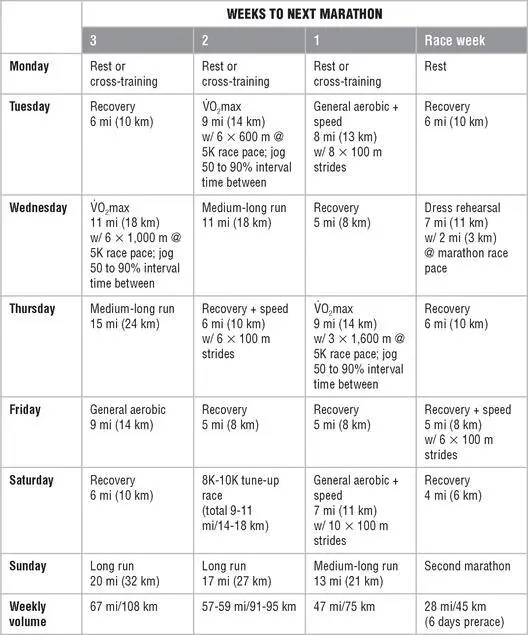

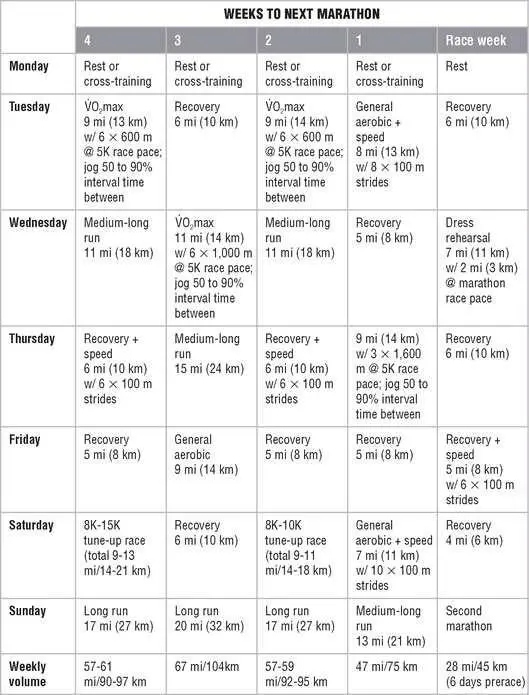
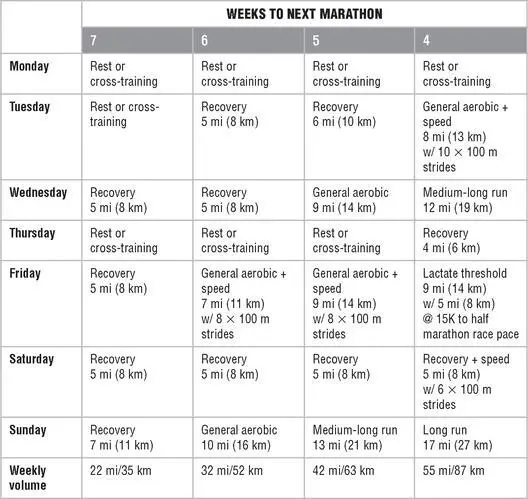

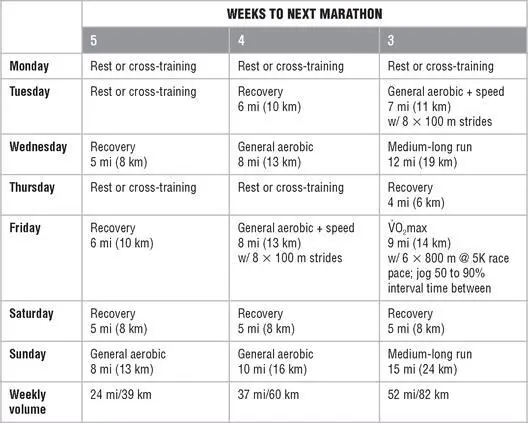
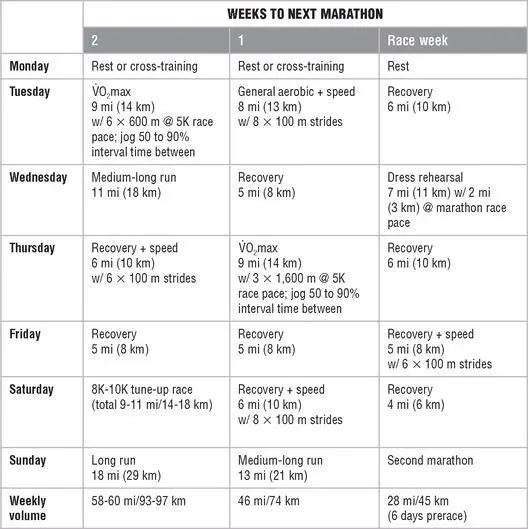
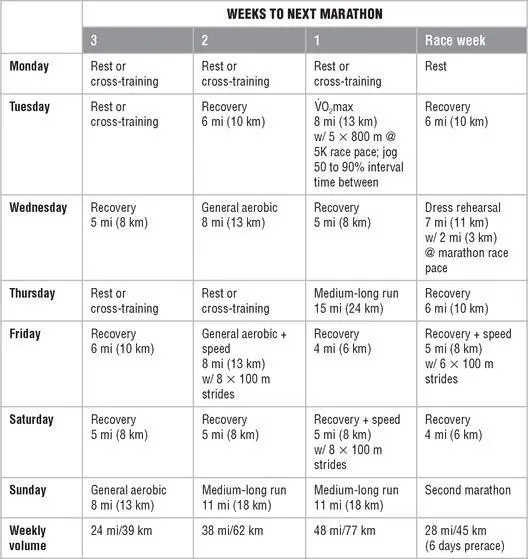
Appendix A
Marathon Race-Pace Chart
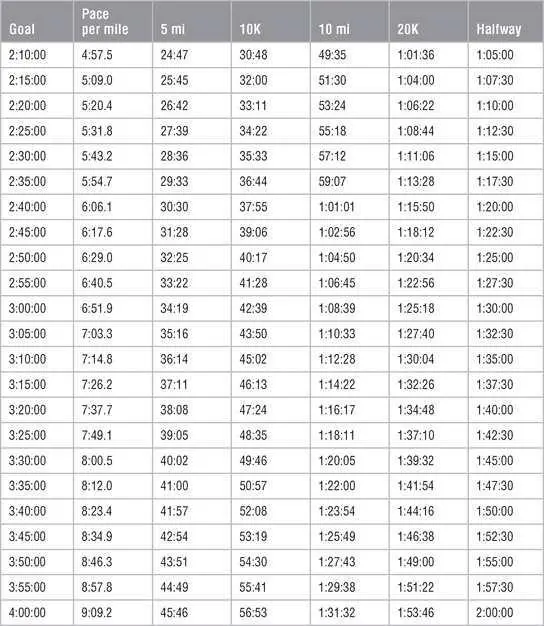
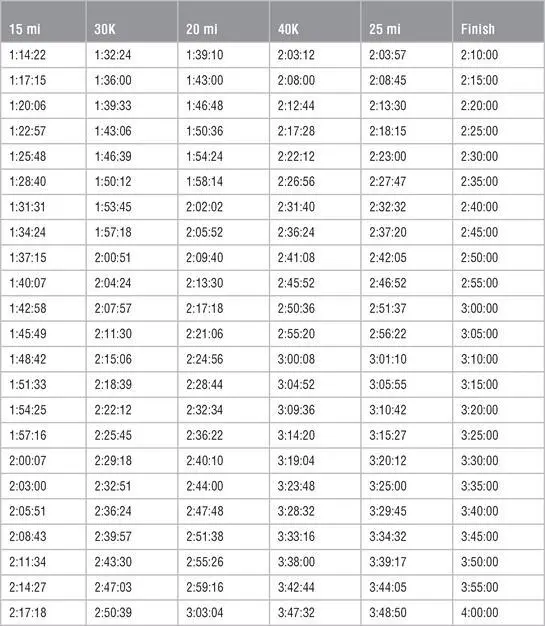
Appendix B
Lactate-Threshold Workout Charts
The training schedules in this book call for doing lactate-threshold workouts between your current 15K and half marathon race pace, in tempo runs of 4 to 7 miles (6 to 11 km). The charts that follow give per-mile and split times for tempo runs based on these parameters. The charts include roughly equivalent race times – for example, a 58:00 15K is roughly equivalent to a 1:24 half marathon – so you should be able to find the narrow range of paces to run to provide the greatest stimulus to improve your lactate threshold.
Slower runners should run closer to their 15K race pace on tempo runs. Faster runners should run closer to their half marathon race pace during these workouts. Remember, though, that it’s important to run your tempo runs at an even pace. Doing so provides a greater stimulus for boosting your lactate threshold than doing a 5-miler (8 km) in which you finish with the same time but during which you start fast, lag in the middle, and finish fast.
If you’ll be doing your tempo runs on a track, bear in mind that on a 400-meter track, four laps at a given pace will be short a few seconds per mile. For example, 20 laps at 85 seconds per lap take 28:20. During this time, you’ll have covered 8K, which is almost 50 meters short of 5 miles, so you haven’t quite averaged 5:40 per mile on this tempo run.

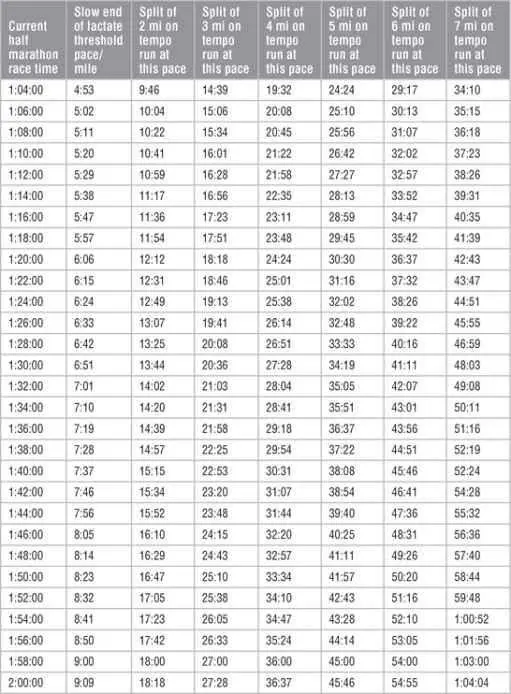
Appendix C
 O 2 max Workout Chart
O 2 max Workout Chart
The training schedules in this book call for doing  O 2max workouts at your current 5K race pace, in repeat segments of 600 meters to 1,600 meters. By current 5K race pace, we mean a race run on a reasonable course in good conditions – not, say, a hilly 5K on a cold, windy day.
O 2max workouts at your current 5K race pace, in repeat segments of 600 meters to 1,600 meters. By current 5K race pace, we mean a race run on a reasonable course in good conditions – not, say, a hilly 5K on a cold, windy day.
The chart that follows gives lap and split times on a standard 400-meter track for workouts based on 5K race times of 14:00 to 24:30. (One mile is almost 10 meters longer than four laps of a 400-meter track, so the 1,600-meter splits are slightly faster than the per-mile pace for a given 5K time.)
Читать дальшеИнтервал:
Закладка:
Похожие книги на «Advanced Marathoning»
Представляем Вашему вниманию похожие книги на «Advanced Marathoning» списком для выбора. Мы отобрали схожую по названию и смыслу литературу в надежде предоставить читателям больше вариантов отыскать новые, интересные, ещё непрочитанные произведения.
Обсуждение, отзывы о книге «Advanced Marathoning» и просто собственные мнения читателей. Оставьте ваши комментарии, напишите, что Вы думаете о произведении, его смысле или главных героях. Укажите что конкретно понравилось, а что нет, и почему Вы так считаете.










